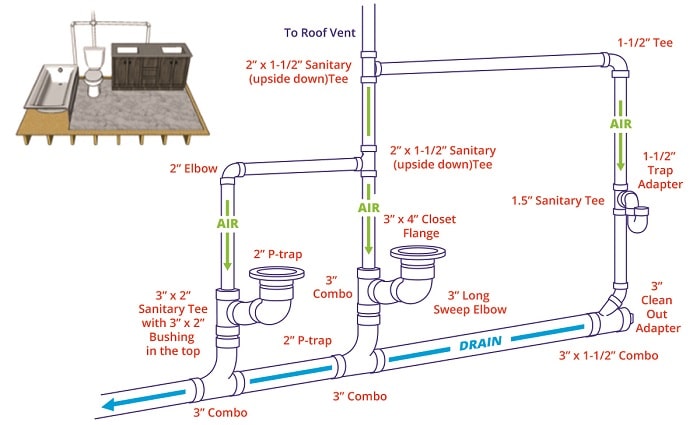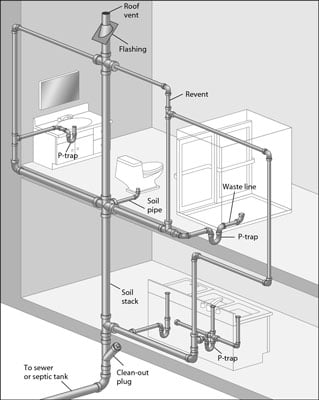The bathroom sink plumbing vent, also known as a vent pipe or vent stack, plays a crucial role in maintaining proper drainage and preventing sewer gases from entering the bathroom. It is a vertical pipe that extends from the drainage system of the sink and connects to the main plumbing vent stack or venting system of the house. The purpose of the vent is to allow air to enter the drainage system, equalizing pressure and preventing airlocks or suction that can impede drainage and cause unpleasant odors. Additionally, the vent provides a means for sewer gases to escape safely to the exterior of the building, protecting the health and safety of occupants.
The plumbing vent typically extends through the roof of the house, allowing fresh air to enter the drainage system from above. This ensures that the drainage system remains properly vented and prevents the accumulation of gases or odors within the pipes. The vent also helps to maintain the proper flow of water through the drainage system, reducing the risk of clogs or backups that can lead to water damage and costly repairs.

In addition to its functional role, the bathroom sink plumbing vent also plays a role in meeting building code requirements for plumbing systems. Most building codes require that plumbing fixtures, including sinks, toilets, and showers, be vented to the exterior of the building to ensure proper drainage and ventilation. Failure to install a vent or maintain proper venting can result in code violations and may pose health and safety risks to occupants.
When installing or repairing a bathroom sink plumbing vent, it’s essential to follow local building codes and regulations to ensure compliance and safety. The vent pipe should be installed at the correct angle and height to facilitate proper drainage and ventilation. Additionally, the pipe should be securely fastened and sealed to prevent leaks or damage. Regular inspections and maintenance of the vent pipe are also important to ensure that it remains free of obstructions and functioning properly.

The bathroom sink plumbing vent is an essential component of the drainage system in any bathroom. It helps to maintain proper drainage, prevent sewer gases from entering the building, and ensure compliance with building codes and regulations. By understanding the role and importance of the plumbing vent, homeowners can ensure that their bathroom plumbing systems remain safe, efficient, and free of unpleasant odors or backups.
How to properly add air vent to bathroom pop up drain Plumbing

Types of Plumbing Traps and How They Work

Plumbing Tips That Will Save You Money *** Click image for more

Everything You Need to Know About Venting for Successful DIY
Magic Vent® Video
Can Air Admittance Valve under bathroom sink fix bathtub drain
How to Install an AAV (Air Admittance Valve) for a Sink
Figuring Out Your Drain-Waste-Vent Lines – dummies
Plumbing Vent Distances & Routing Codes
How Does Your Bathroom Sink Drain And Vent Pipes Work?
Related articles:
- Replace Bathroom Sink Faucet Knobs
- Bathroom Sink Pop Up Stopper Repair
- Bathroom Sink Drain Components
- Bathroom Sink With Metal Legs
- Different Bathroom Sinks
- Square Bathroom Sink Bowls
- Bathroom Sink 500mm
- Slow Bathroom Sink Drain Home Remedy
- Bathroom Sink Without Overflow
- Bathroom Sink Not Draining Fast Enough
Bathroom Sink Plumbing Vent: A Comprehensive Guide
The plumbing system in a house is an intricate network of pipes, valves, and vents that work together to ensure that water flows smoothly and waste is carried away efficiently. One of the crucial components of this system is the plumbing vent. Plumbing vents are essential for maintaining proper drainage and preventing sewer gases from entering your home. In this article, we will discuss everything you need to know about bathroom sink plumbing vents.
What is a Bathroom Sink Plumbing Vent?
A plumbing vent is a pipe that extends from the drainage system of your home up through the roof. It allows air to enter the plumbing system and equalize the pressure created by water flowing through the pipes. Without a vent, water would not drain properly, and you would experience slow drains, gurgling sounds, and unpleasant odors.
In a bathroom sink, the plumbing vent connects to the drain pipe beneath the sink. The vent pipe runs vertically upwards from the drain pipe and exits through the roof of your house. It allows air to enter the drainpipe and prevents it from becoming clogged with water or waste.
Why Do You Need a Bathroom Sink Plumbing Vent?
A bathroom sink plumbing vent is necessary for several reasons:
Proper Drainage: The vent allows air to enter the drainpipe, which prevents water from being trapped in the pipes. Without a vent, water would not flow out of your sink properly, leading to slow drains and backups.
Odor Control: The vent pipe helps to prevent foul odors from entering your home by allowing sewer gases to escape through the roof.
Prevents Damage: A blocked or clogged drainpipe can cause damage to your sink and pipes over time. A plumbing vent helps prevent clogs by allowing air to enter the drainpipe.
How Does a Bathroom Sink Plumbing Vent Work?
When you turn on your faucet, water flows out of the spout and down into the drainpipe. The force of the water creates a vacuum in the drainpipe, which can cause water to be trapped in the pipes and prevent proper drainage. The plumbing vent allows air to enter the drainpipe, equalizing the pressure and allowing water to flow freely.
The vent also helps to prevent sewer gases from entering your home. As waste flows through the drainpipe, it produces gas that can be harmful if inhaled. The vent pipe allows these gases to escape through the roof instead of entering your home.
How Do You Install a Bathroom Sink Plumbing Vent?
Installing a bathroom sink plumbing vent requires some plumbing knowledge and experience. It is typically done by a professional plumber. Here are the steps involved in installing a plumbing vent:
Determine the Location: The vent should be installed as close to the bathroom sink as possible. The best location is usually above or behind the sink.
Cut a Hole: A hole must be cut in the wall or ceiling where the vent will exit your home.
Install the Vent Pipe: The vent pipe is attached to the drain pipe beneath the sink and runs vertically upwards through the wall or ceiling and out through the roof.
Connect to Roof Flashing: The vent pipe must be connected to the roof flashing to ensure that water does not leak into your home.
Seal Around Pipe: Sealant must be applied around the pipe where it exits your home to prevent water from entering.
Can I install a bathroom sink plumbing vent myself?
It is recommended that you hire a professional plumber to install a plumbing vent as it requires knowledge and experience.
How do I know if my bathroom sink plumbing vent is working properly?
If you notice slow drains, gurgling sounds, or foul odors coming from your sink, it may be an indication that your plumbing vent is not working correctly.
Can I install a bathroom sink without a plumbing vent?
It is not recommended to install a bathroom sink without a plumbing vent as it can cause drainage problems and unpleasant odors.
How often should I have my bathroom sink plumbing vent inspected?
It is recommended to have your plumbing vent inspected annually by a professional plumber to ensure that it is working correctly.
A bathroom sink plumbing vent is an essential component of your home’s plumbing system. It allows air to enter the drainpipe, equalizing pressure and preventing clogs and foul odors. If you suspect that your plumbing vent is not working correctly, it is essential To have it inspected by a professional plumber to avoid further damage and potential health hazards. Installing a plumbing vent requires knowledge and experience, so it is best left to the experts.
Regular maintenance and inspections can ensure that your plumbing vent continues to function correctly and prevent any future issues with your bathroom sink drainage. I do not have personal opinions. However, it is important to note that proper plumbing venting is crucial for the health and safety of your home’s occupants, as well as the integrity of your plumbing system. It is always recommended to hire a professional plumber for installation and maintenance to ensure that your plumbing vent is working correctly.






